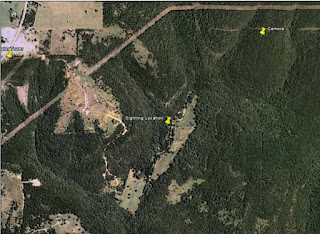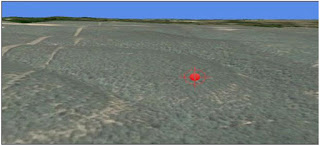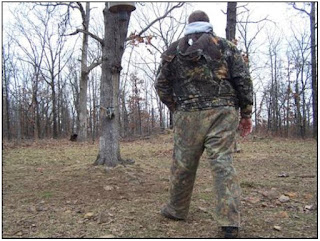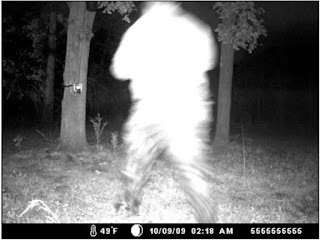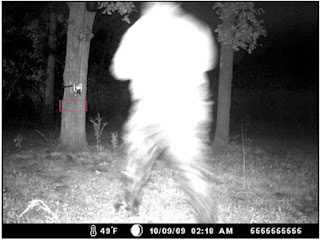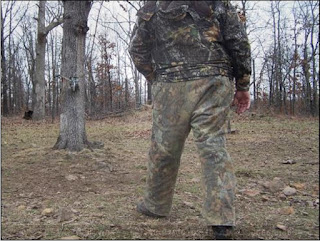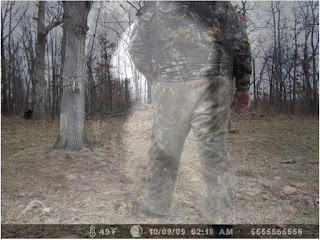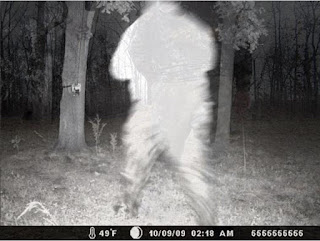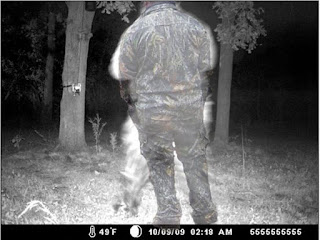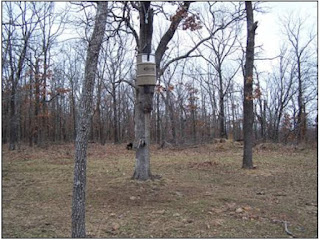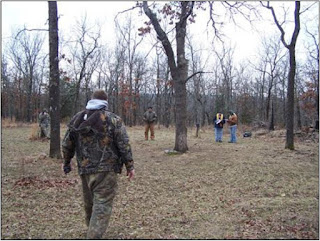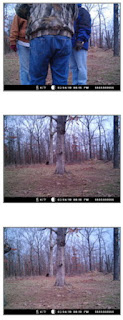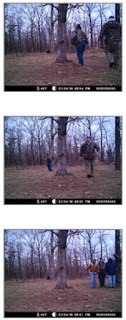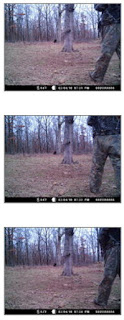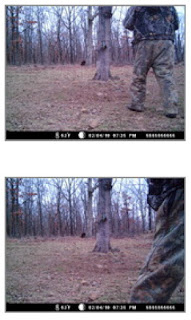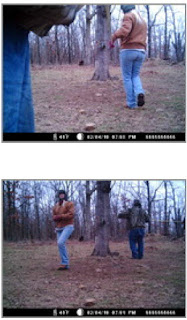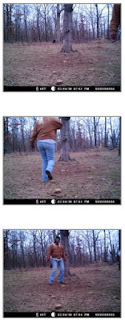Oklahoma Trail Camera Picture Investigation 2009-10
- Details
- Category: Uncategorised
- Published: Monday, 26 April 2021 16:13
- Written by Super User
- Hits: 12691
Table of Contents
Summary
Overview of area
The Photo
Trail Camera Information
Deer Feeder Information
Winch Information
Test Subject Information
Camera Location Information
Sighting Location Information
The Photo Analysis
Conclusion
Misc. Photos
Additional Notes
Summary
On October 8, 2009, the landowner had his trail camera activated by a large bi-pedal figure at approximately 7:00 PM at a private deer feeding/hunting plot established on his property. This occurred about 3 days after his son spotted what appeared to be a large, black bi-pedal figure running down a hillside from another nearby deer feeding/hunting plot.
Due to the extensive expense the owner has incurred in setting up these deer feeding/hunting plots on his property, he was inclined to protect his investment in feed and equipment, not allowing the MABRC to go into to investigate until after deer hunting season was over.
On February 7, 2010, Team Stilwell of the MABRC was granted access to the location to do measurements and review the area in question, to either collaborate or debunk the photo and the figure in the photo. Present were D.W. Lee, Bobbie Lee, Carrie Schulze, Robert Johnson and Larry Coleman from the MABRC, and the Landowner, B.F.
Overview of area
The landowner states that his property is over 700 acres in size, with three large fields, the rest being woodland. The only access to the area is through 4 locked gates along one road. A hi-voltage power line right-of-way intersects the western and northern sides of the property, which connects with the right-of-way that goes to Skilleyville and the bait stations.
In figure 1 below, you will see that the right-of-way connects the locations on the Google Earth screen capture. The thin whitish line that crosses the wooded areas is the right-of-way.
Figure 1: (above) Regional Overview with right-of-ways. This has significance in that the MABRC has a working theory that Bigfoot tend to use right-of-ways as a means of navigation.
Figure 2 (below) shows the main section of the property, including the location of the entrance road from the highway, the single road into the property and the location of the trail camera where the picture was taken.
File comment: Figure 3 (below) shows the location of the 4 locked gates on the property in relation to the sighting and the camera location.
The Photo
In this report, the photo will be shown for reference, the owner still claims copyright and this photo is not for public distribution. In the photo, you see a large bi-pedal figure as it moves past the camera tree and heads towards the deer feeder bucket on tree #1. The washout effect is due to the close proximity of the subject to the camera and its IR flash; this is evident in later pictures of deer that have come to close to the camera in the same series of photos.
The temperature and moon phase is correctly shown on the camera, however, upon examination; the camera time was off by 7 hours approximately. This would put the picture being taken a little after 7 PM on October 8, 2009. The camera LED display had stopped functioning and the land owner could not see to set the correct time on the camera.

Figure 4. The above picture was taken of a bi-pedal figure at approximately 7 pm, 10/08/09 with a nearly full moon that rose at 9:48 pm with the sun setting at 6:53 pm. The illumination on the left-hand side of the picture on the foliage is a result of the setting sunlight. Measurements were taken of all identifiable items in the picture here and of one in the daylight. Those items were designated with numbers for identification purposes.
The figure appears to have hair, and the length of the left foot can be seen extending outward.
The arms appear to be bent at the elbows and the forearms are in front of the figure.

Figure 5. This picture was taken of a deer an hour and 18 minutes after the bi-pedal figure crossed in front of the camera. Note the wash-out caused to the deer from the IR flash. Life-long deer hunters estimate the height of this deer at possibly 4 feet tall to the top of its head.
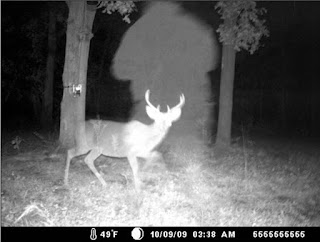
Figure 6. This is a composite photo of the two pictures above, in which the bi-pedal figure photo was adjusted with transparency of 40% through Photoshop and placed over the deer image. When this was done, the height of the deer feeder bucket is clearly shown to have changed height during the time lapse of the two photos. Further review also noted that the handle of the winch was placed nearly back in its original location, with a slight difference of an inch or two.
While the deer is clearly farther back, it is estimated that the deer is within 4 to 5 feet from the bi-pedal figure’s front foot. It’s evident that the size of the bi-pedal figure is very bulky.
Trail Camera Information

Figure 7. Picture shows the trail camera mounted on the tree it was on during the bi-pedal figure’s transversing the area in front of it. It came basically from the direction where the MABRC member in the brown jacket is standing at.
Camera type: Moultrie – Digital MultiCam II
Direction of camera during picture: 50° East on the compass
Current time and date on camera: LED screen has stopped functioning on this camera, based on time of investigation being conducted, the time is approximately 7 hours behind regular time. Ex. 7:00 PM is actually Noon.
Height placed on tree: During the investigation, it was placed at 2’ from the ground, after evaluation of the pictures taken during the investigation, the camera was mounted possibly about 3’ from the ground.
Attached to tree by which means: one strap.
Questions asked of land owner concerning deer feeder/hunting plot:
1. Has camera always been placed at the feeding station, or was it
placed there randomly? June to the end of deer hunting season.
2. Is feed placed in the feeder year round? No. If not, when is it
usually placed there? With the exception of January and February, year
round.
3. Does either land owner ever replace feed at night? No.
4. Land Owner also stated that he has to carry feed bags over shoulder, it’s
nearly impossible to carry it in front of him in his arms when asked about if
someone could have carried a bag of feed in that manner. Bags are 50 pound
bags.
Deer Feeder Information

Figure 8. The Moultrie Deer Feeder
Deer Feeder type: Moultrie (Model unknown, but is battery powered)
Bucket Width: 18 ½ “ barrel, 6 “ feeder unit
Bucket height: 29” barrel, 9 ½ “ feeder unit

Figure 9. The manual winch that supports the deer feeder bucket.
Winch Type: DL1802A Manual
Winch width: 4 ¾ “
Winch depth: 7”
Winch height: (just the winch itself) 8”
Winch handle length: 10 ¾ “
Height of winch from the ground: 38 ½ “
Is there anything attached to the handle to prevent it from falling
downward? No.
Other information: The handle is tight against the tree, and the bark has been worn down from the handle hitting it. When we arrived, the nut that holds the handle on the winch was off and found nearby.
Test Subject Information
Name: Robert Johnson
Weight: 336 lbs.
Height: 6’ 6”
Shoe Size: 15
Shoulder Width: 26”
Leg Length: (From bottom of foot to crotch) 33”
Arm Length: 26”
Hand Length: 7”
Head width: 8 ½ “
Head height: 11”
Waist width: 21”
Butt Width: 18”
Normal stride length: 18” (from toe to heel)
Robert is a former college football player and currently a high school football
and wrestling coach.
Camera Location Information
The following diagrams and photos show the designation given to each item that was
identifiable and used as measurement tools. The distances, sizes and other related
information are also given too.
Figure 10.
Coordinates of the location: ***********, **************
Distance between camera tree and tree #1: 24’
Distance between camera tree and tree #2: 34’ 8”
Distance between camera tree and rock #1: 18’ 3 ½ “
Distance between camera tree and rock #2: 14’ 4”
Distance of tree #3 from camera tree: 57’ 10”
Direction of tree #1 from camera tree: 50° East
Direction of tree #2 from camera tree: 70° East
Distance of tree #2 from tree #1: 13’ 4”
Height of knot on tree #1: 6’ 3”
Width of knot on tree #1: 12”
Height of knot on tree #1: 11 ½ “
Width of tree #1: 13 ¾ “
Width of tree #2: 10 ½ “
Width of tree #3: 16 ½ “

Figure 11. A rough diagram showing the layout of the location, including the deer stand (red square). The shortest route to the road in would have been behind the camera tree, not in front of it.
Figure 13. This is the view of the terrain and the location of the trail camera area looking from the western side. The elevation would continue getting sunlight long after other areas would fall into darkness.
Sighting Location Information
Coordinates of the location: ************, *************
The landowner’s son and father were in a deer hunting stand on the property. As explained by the landowner, the grandfather had fallen asleep in the stand while the grandson continued looking out the firing slit, when he noticed the creature walking along the hillside. The grandson tried to wake the grandfather up to see the creature, but by the time the grandfather woke up, the creature had moved off to the north of the field. The field is about ¾ of an acre in size, and is surrounded by barbed wire strands to keep the cattle out of the peas that are planted there to draw in the deer. The creature was described as large, bi-pedal and black, and was thought to be jumping over logs as it traveled across. The grandson thought it had been approaching the field when it realized someone was in the hunting stand.
Figure 14. The direction the creature was moving in relation to the deer stand, in a northerly direction.
Figure 15. Deer Hunting Stand where son and grandfather were in.

Figure 16. The creature was seen going in a northerly direction along the hillside as shown in the above picture with the red arrow.

Figure 17. The creature continued moving towards the north along this spline (see above) until it disappeared into the draw behind it.
Figure 18. It appears to have continued in a northerly direction after it passed the field as shown above in the picture. This is only an assumption based on the direction of travel.
Figure 19. A view inside the deer hunting stand.
Analysis
The plan was developed to have Robert Johnson stand in as near as position as
the bipedal figure to use as a measurement to the size of the figure in the photo.
To accomplish this, several pictures of the series were printed out in 8 ½ “ X 11”
sheets, one of the figure itself, one of the deer taken an hour and 18 minutes later,
and one of the daytime taken by the trail camera.
The daytime photo was used to identify rocks and other landmarks in the
nighttime photo to give a better indication of where the figure’s feet were
placed at.
Once the investigation team arrived on site, multiple pictures from different views
were taken for reference to the location. Once the landmarks were identified and
agreed upon by the team, measurements were taken and documented and the
process of lining Robert up in the same location began.
Once it was determined to be close to the exact spot, multiple pictures were
taken by the trail camera and with a digital camera.
Once the pictures were loaded onto the computer, the analysis began.
Step one, was to find one of the photos taken for comparison that would match
up the best with the original figure.
The photo selected was labeled 100_5063 with the dimensions of 2576 X 1932 pixels.
Figure 21. Original photo
What was done was take a portion of tree #1 that was readily identifiable, as a cross section from the 100_5063 photo, and moved onto the original photo, enlarging the original’s dimensions, until the cross sections matched.
Figure 22. The red box signifies the portion of the tree used in the comparison on both photos. While not completely scientific, this was the best method to determine the size of the tree in both photos.
Figure 23. This gave as near an accurate measurement to superimpose
the photos over each other, moving the tree in both pictures to match
up their roots and as near to the winch as possible.
The resultant comparison photo series shows the transition between Robert and
the original figure. The first photo shows Robert at 100% opacity, and each
subsequent photo is reduced by 10% transparency until he completely disappears
from the last photo in the series.

Figure 24. 100% Opacity, only the photo of Rob is viewable, the image has been adjusted to match the tree with the winch on it.
Figure 25. 10% transparency is applied to the next photo
Figure 26. 20% transparency is now applied, you can begin to see the outline of the bi-pedal figure in comparison to Robert.

Figure 27. 30% transparency has been applied, further detail of the bi-pedal figure is now viewable compared to Robert
Figure 28. 40% transparency has been applied, further detail of the bi-pedal figure is now viewable compared to Robert.

Figure 29. 50% transparency has been applied, further detail of the bi-pedal figure is now viewable compared to Robert.

Figure 30. 60% transparency has been applied, further detail of the bi-pedal figure is now viewable compared to Robert.

Figure 31. 70% transparency has been applied, further detail of the bi-pedal figure is now viewable compared to Robert.
Figure 32. 80% transparency has been applied, further detail of the bi-pedal figure is now viewable compared to Robert.
Figure 33. 90% transparency has been applied to the photo of Robert, and very little detail is left of his figure in the photo now. The size of the bi-pedal figure is smaller than Robert by an estimate of 18 inches. The bulk of the figure though still shows sizable girth.

Figure 34. With 100% transparency applied to Robert’s photo, all that is viewable is the original photo. Clearly, the figure is not as tall as previously thought.
Despite assurances from the landowner that no one would be up there after dark, it was decided by the analyst on the photos, to take a photo of the landowner, shown here, and compare his body style with the bi-pedal figure.

Figure 35. The photo used, landowner has back towards camera. Since his body was leaning in a different direction from that of the bi-pedal figure, the photo was horizontally flipped as shown below.
Figure 36. The landowner’s figure was cut out of the photo, and trimmed up with an eraser function in Photoshop to clear away the surrounding foliage around him.

Figure 37. And then superimposed on the original photograph after adjusting the pixel size to match up with that of the original. The transparency was adjusted to allow the original bi-pedal figure to be aligned up with the landowner’s figure.

Figure 38. As can be seen, the shoulders of the bi-pedal figure and the landowner matches on the slant and the length. Further analysis shows that the bi-pedal figure’s leg length matches that of the landowner too.
Originally, when the landowner discovered this photo in the series of pictures on the camera, it was just a few days after a possible sighting of a bi-pedal creature by his son less than a ¼ mile away, that was heading in the direction of the trail camera area. It was possibly this sighting that caused most who viewed the photo to believe it could be a Bigfoot.
Upon traveling to the area, the investigation team saw that the remoteness of the area made it hard for an average person to get to the area and walk before the camera.
With the measurements, original photo, test subject, comparison photos, and viewing the actual site, it’s the analyst team’s conclusion, that the landowner is the individual who is caught in the original photo.
The hair illusion is possibly created from the camouflaged fatigues being worn by the landowner, as much of the fabric used in camouflage clothing contain dyes that reflect and enhance ultraviolet light. These optical whiteners and brighteners contain dyes make clothing glow brightly to the eyes of certain animals, making the wearer very visible. A company called Atsko makes a product called UV-Killer that can be sprayed on clothing to destroy these chemicals and their “glow in the day” effect. The possibility that this is affecting the IR flash on the camera into giving a flowing hair effect is pretty strong. Further study would need to be done on that theory to make sure it’s feasible though.
The sighting that occurred, does give credence to this being an active area, however the trail camera picture evidence points strongly to the landowner being the bi-pedal figure. Based on this information, the analyst team recommends closing the file on this picture.
Figure 41. Bobbie is recording video of the investigation, while Carrie looks down into the woods.

Figure 42. A comparison shot of Robert trying to locate the right location of the
bi-pedal figure’s footsteps.

Figure 44. The road leading up to the location, notice the incline to the left of the truck, this is a pit used to burn the trees knocked down to create this deer feeding/hunting plot.

Figure 45. A view from the roadway towards the camera location. Larry is trying to direct Robert to the exact location the bi-pedal figure was at when the photo was taken.
Figure 47. Larry is trying to line up Robert to match up the location of the bi-pedal figure’s footsteps.
Figure 48. A comparison shot of Robert trying to locate the right location of the bi-pedal figure’s footsteps.
Figure 56. Visiting with the landowner at the location of his son’s sighting
Additional notes
Exif Information for original photo:
Filename : my spot 10 21 09 001.JPG
JFIF_APP1 : Exif
JFIF_APP1 : http
Main Information
ImageDescription :
Make : Digital MultiCam II
Model : Moultrie Game Camera
Orientation : left-hand side
XResolution : 288/3
YResolution : 288/3
ResolutionUnit : Inch
Software : FW Ver. 4.04.04
DateTime : 2009:10:09 02:18:01
YCbCrPositioning : co-sited
Copyright :
ExifInfoOffset : 2334
Unknown (9C9E)1,34 :
6D0079002000730070006F0074002000310030002000320031002000300039000000
Unknown (EA1C)7,2060 : 2060 Bytes
Sub Information
ExposureTime : 1/5.8Sec
FNumber : F2.8
ExposureProgram : Aperture Priority
ISOSpeedRatings : 0
ExifVersion : 0210
DateTimeOriginal : 2009:10:09 02:18:01
DateTimeDigitized : 2009:10:09 02:18:01
ComponentConfiguration : YCbCr
CompressedBitsPerPixel : 4470128/2036928 (bit/pixel)
ShutterSpeedValue : 1/11Sec
ApertureValue : F1.0
ExposureBiasValue : EV0.0
MaxApertureValue : F3.6
MeteringMode : Division
LightSource : Unidentified
Flash : Fired(Auto)
MakerNote : Unknown Format : 460Bytes (Offset:4856)
FlashPixVersion : 0100
ColorSpace : sRGB
ExifImageWidth : 1648
ExifImageHeight : 1236
RelatedSoundFile : RelatedSound
ExifInteroperabilityOffset : 5318
ExposureIndex : 1/1
SensingMethod : OneChipColorArea sensor
FileSource : DSC
SceneType : A directly photographed image
Unknown (EA1C)7,2060 : 2060 Bytes
Unknown (EA1D)9,1 :
ExifR98
ExifR : R98
Version : 0100
Thumbnail Information
Compression : OLDJPEG
XResolution : 1/96
YResolution : 1/96
ResolutionUnit : Inch
JPEGInterchangeFormat : 5484
JPEGInterchangeFormatLength : 5212
Photos from the trail cam while the investigation was ongoing.



